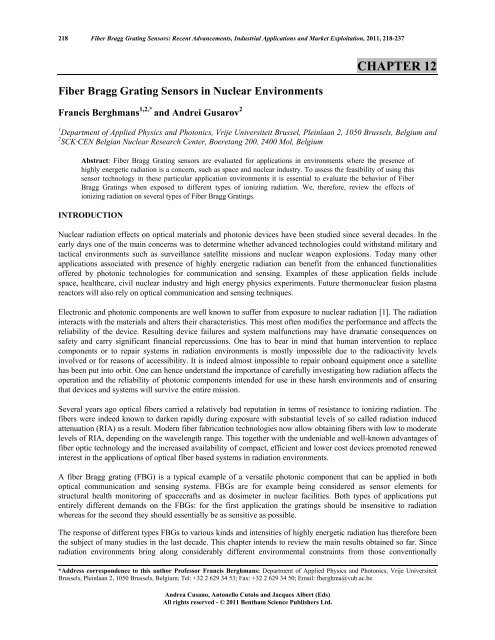chapter 1 - Bentham Science
chapter 1 - Bentham Science
chapter 1 - Bentham Science
You also want an ePaper? Increase the reach of your titles
YUMPU automatically turns print PDFs into web optimized ePapers that Google loves.
218 Fiber Bragg Grating Sensors: Recent Advancements, Industrial Applications and Market Exploitation, 2011, 218-237<br />
Fiber Bragg Grating Sensors in Nuclear Environments<br />
Francis Berghmans 1,2,* and Andrei Gusarov 2<br />
Andrea Cusano, Antonello Cutolo and Jacques Albert (Eds)<br />
All rights reserved - © 2011 <strong>Bentham</strong> <strong>Science</strong> Publishers Ltd.<br />
CHAPTER 12<br />
1 Department of Applied Physics and Photonics, Vrije Universiteit Brussel, Pleinlaan 2, 1050 Brussels, Belgium and<br />
2 SCK·CEN Belgian Nuclear Research Center, Boeretang 200, 2400 Mol, Belgium<br />
Abstract: Fiber Bragg Grating sensors are evaluated for applications in environments where the presence of<br />
highly energetic radiation is a concern, such as space and nuclear industry. To assess the feasibility of using this<br />
sensor technology in these particular application environments it is essential to evaluate the behavior of Fiber<br />
Bragg Gratings when exposed to different types of ionizing radiation. We, therefore, review the effects of<br />
ionizing radiation on several types of Fiber Bragg Gratings.<br />
INTRODUCTION<br />
Nuclear radiation effects on optical materials and photonic devices have been studied since several decades. In the<br />
early days one of the main concerns was to determine whether advanced technologies could withstand military and<br />
tactical environments such as surveillance satellite missions and nuclear weapon explosions. Today many other<br />
applications associated with presence of highly energetic radiation can benefit from the enhanced functionalities<br />
offered by photonic technologies for communication and sensing. Examples of these application fields include<br />
space, healthcare, civil nuclear industry and high energy physics experiments. Future thermonuclear fusion plasma<br />
reactors will also rely on optical communication and sensing techniques.<br />
Electronic and photonic components are well known to suffer from exposure to nuclear radiation [1]. The radiation<br />
interacts with the materials and alters their characteristics. This most often modifies the performance and affects the<br />
reliability of the device. Resulting device failures and system malfunctions may have dramatic consequences on<br />
safety and carry significant financial repercussions. One has to bear in mind that human intervention to replace<br />
components or to repair systems in radiation environments is mostly impossible due to the radioactivity levels<br />
involved or for reasons of accessibility. It is indeed almost impossible to repair onboard equipment once a satellite<br />
has been put into orbit. One can hence understand the importance of carefully investigating how radiation affects the<br />
operation and the reliability of photonic components intended for use in these harsh environments and of ensuring<br />
that devices and systems will survive the entire mission.<br />
Several years ago optical fibers carried a relatively bad reputation in terms of resistance to ionizing radiation. The<br />
fibers were indeed known to darken rapidly during exposure with substantial levels of so called radiation induced<br />
attenuation (RIA) as a result. Modern fiber fabrication technologies now allow obtaining fibers with low to moderate<br />
levels of RIA, depending on the wavelength range. This together with the undeniable and well-known advantages of<br />
fiber optic technology and the increased availability of compact, efficient and lower cost devices promoted renewed<br />
interest in the applications of optical fiber based systems in radiation environments.<br />
A fiber Bragg grating (FBG) is a typical example of a versatile photonic component that can be applied in both<br />
optical communication and sensing systems. FBGs are for example being considered as sensor elements for<br />
structural health monitoring of spacecrafts and as dosimeter in nuclear facilities. Both types of applications put<br />
entirely different demands on the FBGs: for the first application the gratings should be insensitive to radiation<br />
whereas for the second they should essentially be as sensitive as possible.<br />
The response of different types FBGs to various kinds and intensities of highly energetic radiation has therefore been<br />
the subject of many studies in the last decade. This <strong>chapter</strong> intends to review the main results obtained so far. Since<br />
radiation environments bring along considerably different environmental constraints from those conventionally<br />
*Address correspondence to this author Professor Francis Berghmans: Department of Applied Physics and Photonics, Vrije Universiteit<br />
Brussels, Pleinlaan 2, 1050 Brussels, Belgium; Tel: +32 2 629 34 53; Fax: +32 2 629 34 50; Email: fberghma@vub.ac.be

















